The Friends of the Wildflower Garden, Inc.
Grasses of the Eloise Butler Wildflower Garden
The oldest public wildflower garden in the United States
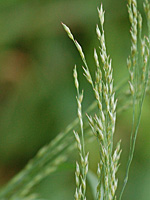
Common Name
Switchgrass
Scientific Name
Panicum virgatum L.
Plant Family
Poaceae (Grasses)
Garden Location
Upland
Prime Season
August to September Flowering
Grass structure and definitions - PDF from Oregon State University
Switch Grass is an erect native perennial grass, growing from 15 inches to 9 feet high. The stem (culm) is round, usually with a reddish to purplish tint on the internodes. Nodes are smooth.
Leaves: Leaf blades are up to 1/2 inch wide (12 mm) and 4 to 24 inches long (10-60 cm), with distinct veins, a prominent mid-vein, usually smooth on upper and lower surfaces, but with a distinctive white patch of hair where the upper surface attaches to the stem. Sometimes the upper surface of the blade may have dense fine hair. Blade margins are usually rough.
Sheaths & Ligules: The leaf sheath is split and also prominently veined, usually with sparse long hair on the margins. The lower sheaths are longer than the internodes, the upper sheaths shorter. Ligules are 2 to 6 mm long and membranous.
The Inflorescence is an open spreading panicle, often being 18 inches in length and often as wide. Spikelets are produced at the ends of the many branches of the panicle. Primary branches usually rebranch once.
Spikelets: Each spikelet will be 2.5 to 8 mm long and 1.2 to 2.5 mm wide, containing an upper and a lower floret. The glumes are distinctly veined, the lower 5 to 9 veins, the upper 7 to 11 veins. The upper glume and lower lemma extend beyond the upper floret and gaping at the top. The lower glume is 1.8 to 3.2 mm long, from 1/2 to 4/5 as long as the spikelet. Within the spikelet, the upper floret is bisexual and shiny and the lower floret is staminate with 3 anthers.
Uses: Switchgrass is an excellent grass for forage and soil stabilization and now has interest as a renewable biofuel resource. It is often cut for winter hay in agricultural areas. Stands of Switch grass benefit from a periodic spring burn. Native varieties self-seed and can become aggressive. Its fall/winter color changes to yellow-orange, providing year-round interest.
Habitat: Switch Grass grows from large scaly rhizomes, the scales closely overlapping. Stems may be single or multiple from the root. Switchgrass requires full sun but tolerates a variety of moisture conditions from dry to wet, in sandy or loamy soil. It's native habitat is the prairie. It is a warm season grass, a sod-former and a common grass of the tall-grass prairie.
Names: The genus name Panicum is from the Latin - either from panis, meaning 'bread, or from panus, meaning an ear of Millet. The genus contains a large number of grass species worldwide, with 30 found just in North America. The species name virgatum, means 'twiggy' or 'wand-like' referring the the spreading branching panicle. The author name for the plant classification, 'L.' refers to Carl Linnaeus (1707-1778), Swedish botanist and the developer of the binomial nomenclature of modern taxonomy.
In former years there were many more species classified as Panicum, but due to molecular studies many of those are now classified in the genus Dichanthelium, of which 12 species are found in Minnesota, many with a common name incorporating the word 'panicgrass'.
For the home garden cultivars have been developed that do not self-seed. One particularly ornamental cultivar, ‘Northwind’ is an outstanding grass. It can reach from 3 to 6 feet in height, needs good sun, at least 5 hours per day for a good plant, tolerates average soil. ‘Northwind’ grows very upright, no sprawling or lodging in hot or rainy weather. The flower heads appear only in late summer on sturdy stems. This is a plant to provide a good tall backdrop, support to weaker specimens, and winter interest. The plants can become quite large so give them some room. Other good cultivars that also have some purple color on some of the leaf blades are 'Shenandoah' and 'Prairie Fire'. These will tolerate some daily shade but the cultivar 'Prairie Sky' will lodge if not given full sun. 'Ruby Ribbons' is a shorter cultivar with much purple color. For details and photos of these plants see our article on Ornamental Grasses.
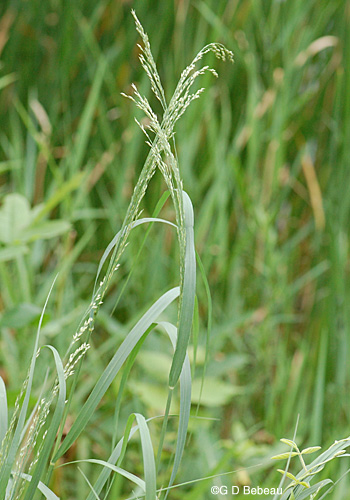
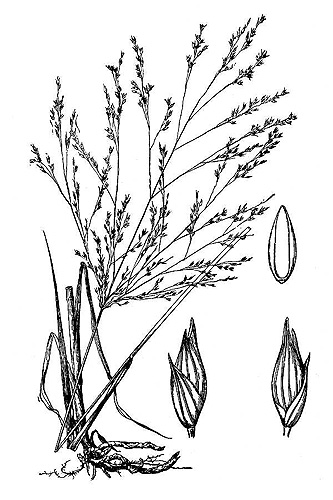
Above: The panicles of Switchgrass at an early stage of development. Drawing courtesy of USDA-NRCS PLANTS Database / Hitchcock, A.S. (rev. A. Chase). 1950. Manual of the grasses of the United States.
Below: 1st photo - Detail of the developing panicle. 2nd photo - Developing spikelets - note position at end of the branches.
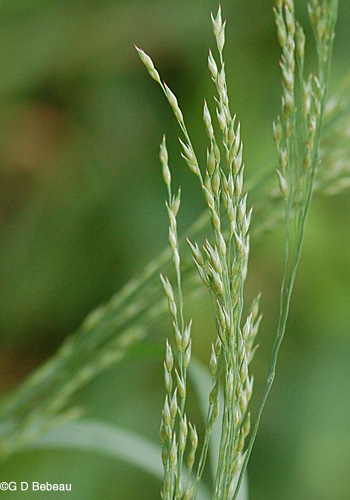
Below: Spikelet detail. Photo ©Anna Gardner, University of Iowa.

Below: Anthers (red) showing on the lower floret and stigmas (brownish) showing on the upper floret; note the veins on the glumes in the first photo.
Below: The rhizomatous root allow the grass to multiply in size vegetatively. Note the overlapping scales.
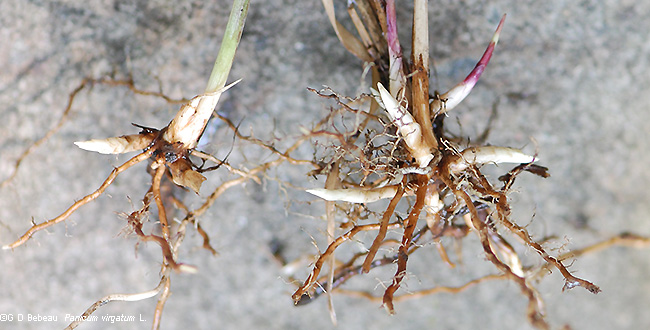
Below: the leaf blade has a distinctive white patch of hair where the upper surface attaches to the stem. The leaf sheath is split and also prominently veined. Note the prominent veins in the nearby leaf blade.
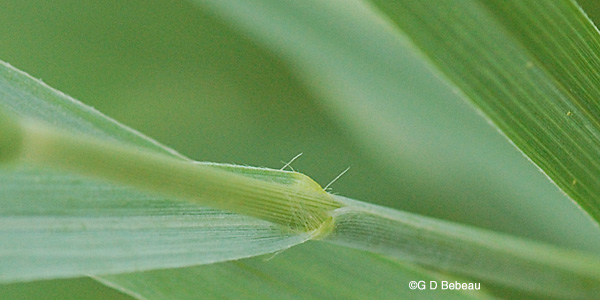
Below: 1st photo - Fall color of switch grass. 2nd photo - Switchgrass with the flowering panicles fully developed. Cultivar 'Shenandoah' shown.
Switchgrass is not considered indigenous to the Garden, but introduced later. Martha Crone did not inventory grasses on her 1951 census, but it was present for the 1986 census. Cary George noted planting it in 1995.
In North America Switch grass is a native perennial found across the United States and Southern Canada except for the West Coast Regions. In Minnesota it is found in most counties, with most of the exceptions being in the north central part of the state.
There are five species of Panicum found in the state: P. capillare, Witch grass; P. dichotomiflorum, Fall Panic Grass; P.miliaceum subsp. miliaceum, Broomcorn millet; P. philadelphicum subsp. philadelphicum, Philadelphia Panic Grass; and P. virgatum, Switchgrass. All are considered native.
Return to -- Site Plan/Archive Index --or-- List of Common Plant Names -- or -- List of Scientific Names -- or --Home Page - - - Back to top.
References: Plant characteristics are generally from sources 1A, 32, W2, W3, W7 & W8 plus others as specifically applied. Distribution principally from W1, W2 and 28C. Planting history generally from 1, 4 & 4a. Other sources by specific reference. See Reference List for details.
 Identification booklet for most of the flowering forbs and small flowering shrubs of the Eloise Butler Wildflower Garden. Details Here.
Identification booklet for most of the flowering forbs and small flowering shrubs of the Eloise Butler Wildflower Garden. Details Here.
©2014
Friends of the Wildflower Garden, Inc. Text and photos are by G. D. Bebeau unless otherwise credited. "www.friendsofeloisebutler.org"
060320